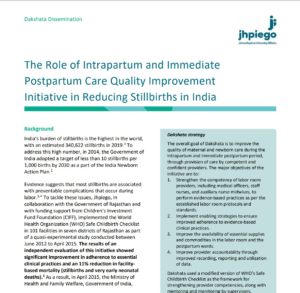
India’s burden of stillbirths is the highest in the world, with an estimated 340,622 stillbirths in 2019. To address this high number, in 2014, the Government of India adopted a target of less than 10 stillbirths per 1,000 births by 2030 as a part of the India Newborn Action Plan.
Evidence suggests that most stillbirths are associated with preventable complications that occur during labor. To tackle these issues, Jhpiego, in collaboration with the Government of Rajasthan and with funding support from Children’s Investment Fund Foundation (CIFF), implemented the World Health Organization (WHO) Safe Childbirth Checklist in 101 facilities in seven districts of Rajasthan as part of a quasi-experimental study conducted between June 2012 to April 2015. The results of an independent evaluation of this initiative showed significant improvement in adherence to essential clinical practices and an 11% reduction in facility based mortality (stillbirths and very early neonatal deaths). As a result, in April 2015, the Ministry of Health and Family Welfare, Government of India, scaled up the initiative throughout the country under the name “Dakshata” (meaning “adroitness”).
Dakshata strategy
The overall goal of Dakshata is to improve the quality of maternal and newborn care during the intrapartum and immediate postpartum period, through provision of care by competent and confident providers. The major objectives of the initiative are to:
- Strengthen the competency of labor room providers, including medical officers, staff nurses, and auxiliary nurse midwives, to perform evidence-based practices as per the established labor room protocols and standards.
- Implement enabling strategies to ensure improved adherence to evidence-based clinical practices.
- Improve the availability of essential supplies and commodities in the labor room and the postpartum wards.
- Improve provider accountability through improved recording, reporting and utilization of data.
Dakshata used a modified version of WHO’s Safe Childbirth Checklist as the framework for strengthening provider competencies, along with mentoring and monitoring by supervisors.
Related tools
- The implementation partners documented their learnings backed by evidence in the form of factsheets for countries, governments, and civil societies to emulate in their respective regions and programs.